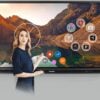Not All Projectors Are Created Equal—Especially in the Classroom
When setting up an interactive classroom or collaborative workspace, one of the most overlooked but critical choices you’ll make is the projector. And it’s not just about brightness or resolution—it’s about throw distance.
I recently spoke with the team at Retechtronics, a trusted supplier of smartboards and projectors for schools and offices, to understand the difference between short-throw and ultra-short-throw (UST) projectors. Their advice helped me make the right call for my own setup—and it can help you too.
What Is “Throw Distance”?
Throw distance refers to how far a projector needs to be from the screen or board to produce a clear, full-size image. The shorter the throw, the closer you can place the projector to the surface without sacrificing image quality or size.
There are three main categories:
- Standard Throw: Requires 6–10 feet or more
- Short-Throw: Typically needs just 3–4 feet
- Ultra-Short-Throw (UST): Can be placed as close as 4–24 inches from the screen
Why It Matters in Real Classrooms and Meeting Rooms
The difference in throw distance directly affects:
- Shadow interference (less with shorter throw)
- Glare in presenters’ eyes
- Space usage in compact rooms
- Installation flexibility and wall-mounting options
According to Retechtronics, many first-time buyers mistakenly choose standard projectors and end up dealing with constant shadow problems and awkward wiring.
Short-Throw Projectors: Best for Mid-Sized Classrooms
What I learned:
Short-throw projectors strike a good balance for most learning environments. They can sit a few feet from the board and still project a crisp, large image. This reduces shadow issues while keeping costs down.
Ideal for:
- Classrooms with moderate space
- Interactive smartboard use (e.g., SMART SB680/885)
- Teachers who want to walk in front of the board without blocking the image
Recommended by Retechtronics:
Models like the Epson BrightLink 585Wi and BenQ MW632ST, which offer interactive capabilities and solid reliability at a reasonable cost.
Ultra-Short-Throw (UST) Projectors: Premium Setup, Minimal Disruption
What I learned:
If you want the cleanest, most polished installation—especially for small rooms—UST is the way to go. You can mount the projector just inches above or below the board, which eliminates nearly all shadows and cable clutter.
Ideal for:
- Small or high-traffic classrooms
- Business conference rooms with limited wall space
- Smartboard + projector bundles that need seamless integration
Retechtronics recommendation:
The Epson BrightLink 695Wi or SMART LightRaise series for ultra-responsive, glare-free projection. These are often bundled with interactive whiteboards in their classroom packages.
Key Differences at a Glance
| Feature | Short-Throw | Ultra-Short-Throw |
|---|---|---|
| Throw Distance | 3–4 feet from screen | 4–24 inches from screen |
| Shadow Reduction | Moderate to low | Near-zero |
| Installation | Flexible but needs wall space | Wall-mounted or cabinet-top |
| Price | Lower to mid-range | Mid to high |
| Best for | Traditional smartboard setups | Tight spaces, polished installations |
What Retechtronics Experts Recommend
If you’re unsure which type to choose, Retechtronics suggests asking:
- How much space is in front of the board?
- Will teachers or presenters regularly stand in front of the display?
- Do you plan to move or mount the projector permanently?
- Is shadow-free performance worth the premium cost?
Their team also offers bundled smartboard + projector kits that are already optimized for classroom layouts—taking the guesswork out of pairing models.
Final Word
Short-throw and ultra-short-throw projectors both have their place. Thanks to Retechtronics‘ guidance, I avoided overpaying for features I didn’t need—and also avoided common setup frustrations.
Whether you’re upgrading a classroom, training room, or home learning space, the throw distance decision will affect not just how your projector looks, but how it works. And with the right setup, your tech disappears into the background—so the learning can shine.












